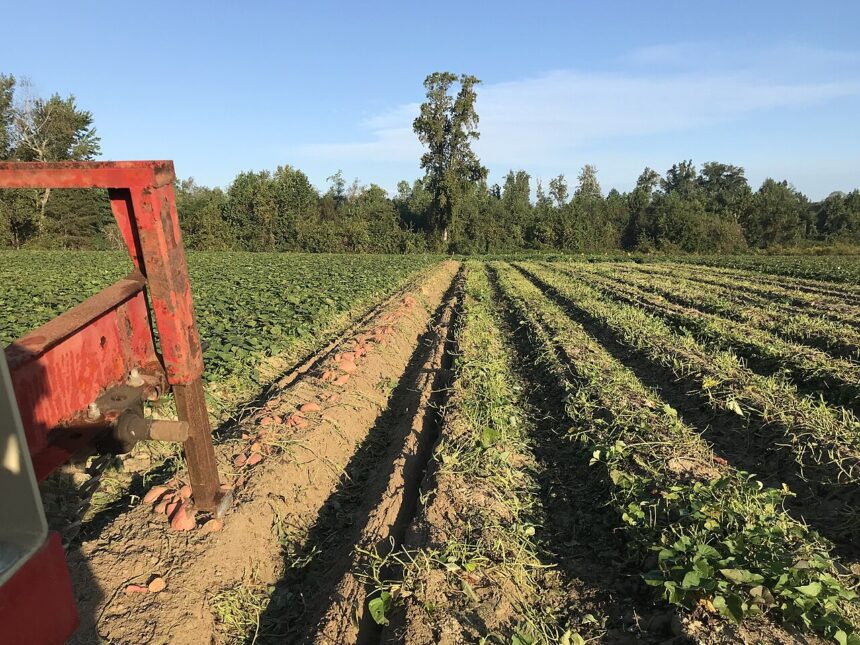Sweet potatoes are a versatile and nutritious crop that can thrive in South Africa’s varied climates. Here’s a comprehensive guide on growing sweet potatoes from planting to harvest, including land preparation, required inputs, pest management, and storage.
1. Land Preparation
Soil Type: Sweet potatoes prefer well-drained, sandy loam soils with a pH between 5.8 and 6.2. Avoid heavy clay soils that can cause tuber rot.
Preparation Steps:
- Clear the Land: Remove any weeds, rocks, or debris from the field.
- Tillage: Plough and harrow the soil to create a loose, friable seedbed. Aim for a bed depth of 20-30 cm.
- Soil Testing: Conduct a soil test to determine nutrient levels and pH. Amend the soil based on test results.
2. Planting
Seed Preparation: Sweet potatoes are typically grown from slips (young shoots) rather than seeds. Obtain healthy, disease-free slips from a reliable source.
Planting Process:
- Spacing: Space slips 30-45 cm apart in rows that are 90-120 cm apart. This spacing ensures ample room for tuber development.
- Planting Depth: Plant slips 5-10 cm deep in the soil. Press the soil firmly around the base of the slip to eliminate air pockets.
3. Watering
Water Requirements:
- Initial Stage: Keep the soil consistently moist for the first 3-4 weeks after planting to promote root establishment.
- Growth Stage: Sweet potatoes require moderate watering. Aim for 25-30 mm of water per week, either through rainfall or irrigation.
- Late Stage: Reduce watering 4-6 weeks before harvest to encourage the development of firm, mature tubers.
Irrigation System: Consider drip irrigation or soaker hoses for efficient water delivery and to reduce weed growth.
4. Fertilization
Types of Fertilizers:
- Pre-Planting: Apply a balanced fertilizer (e.g., 10-10-10) or compost before planting to enrich the soil with essential nutrients.
- During Growth: Apply a side-dressing of potassium-rich fertilizer (e.g., potassium sulfate) during the growing season to support tuber development.
Application Rate: Follow the recommendations based on soil test results and fertilizer package instructions.
5. Weed Control
Weed Management:
- Pre-Emergence: Apply a pre-emergence herbicide (e.g., trifluralin) before weeds and sweet potato slips emerge.
- Post-Emergence: Use mulch or hand weeding to manage weeds around the plants. Avoid herbicides that may damage the sweet potato crop.
6. Pest and Disease Management
Common Pests:
- Sweet Potato Weevil: This pest can cause tuber damage. Use insecticides (e.g., permethrin) if infestation levels are high.
- Aphids: These can transmit viral diseases. Control with insecticidal soap or appropriate pesticides.
Common Diseases:
- Fusarium Wilt: A soil-borne fungus that causes wilting and yellowing. Use resistant varieties and practice crop rotation.
- Cercospora Leaf Spot: Identified by dark, circular spots on leaves. Apply fungicides (e.g., copper-based products) as a preventive measure.
- Root Rot: Caused by excessive moisture and poor drainage. Ensure proper soil drainage and avoid overwatering.
7. Harvesting
Harvest Time: Sweet potatoes are typically ready for harvest 90-150 days after planting, depending on the variety and growing conditions. Harvest when the leaves begin to yellow and die back.
Harvesting Process:
- Manual Harvesting: Use a spade or fork to carefully lift the tubers from the soil. Avoid damaging the tubers.
- Handling: Handle tubers gently to prevent bruising and skin damage.
8. Storage
Post-Harvest Curing:
- Curing: Cure sweet potatoes in a warm, humid environment (around 26-29°C and 85-90% humidity) for 7-10 days. This process improves flavor and storage life.
- Storage: Store cured sweet potatoes in a cool, dry place at 12-15°C. Avoid direct sunlight and maintain good air circulation to prevent rot.
Inputs and Machinery:
- Tillage Equipment: Ploughs, harrows.
- Irrigation Systems: Drip irrigation, soaker hoses.
- Harvesting Tools: Spades, forks, or mechanical harvesters.
- Pesticides and Fertilizers: As per recommendations for pest control and soil nutrient management.
By following these guidelines, South African farmers can effectively grow and manage sweet potatoes, ensuring a successful harvest and efficient storage. Implementing proper practices will enhance crop yield, quality, and sustainability.
Join 'Farmers Mag' WhatsApp Channel
Get the latest Farming news and tips delivered straight to your WhatsApp
CLICK HERE TO JOIN






